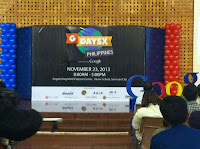GDayX
provided for a more fruitful and productive escape for an otherwise, mundane
and lazy Saturday afternoon for me last 23rd of November, 2013.
At
first, I thought it was just gonna be another boring tech talk about the latest
gadgets used in business today. And of all audiences to single out, they chose
probably the most learned and sophisticated generation to give focus to in such
a talk.
Turns
out, the event had much more knowledge in store for me, stretching far beyond
the confines of day-to-day usage of gadgets and gizmos. The speakers for the
event gave really relevant and useful points not only for aspiring
entrepreneurs, small-medium scale businesses or students, but also to any
modern man who encounters and works with these state-of-the-art gadgets and
innovations.
“Introduction to Google Analytics” was the first talk I
listened to. I knew it really wasn’t the best sounding title for a talk to start
off the day. But however drudgingly lackluster it sounded, the speaker, Maro
Rimorin, who was a Blogger and Digital Strategist, was able to capture his
audience through his natural charisma and of course, the relevant points he
raised regarding Google Analytics and its relation to personal and company
websites.
Google Analytics, in a nutshell, is an online web-tracking
service by Google that provides pertinent information regarding the website
chosen by the user to be tracked. This helps users keep tabs on the development
and progress of their personal or company websites, so they can adapt and make
changes to their website according to the information relayed by Google
Analytics.
For instance, if the bounce rate (which simply means the
times people visit a site and immediately leave without taking time to view its
content) increases, then perhaps the business tied to it, say a restaurant, is
also experiencing a higher bounce rate. Thus, the company will employ
strategies to improve the website or explore other online venues of interaction
with their market. Dealing with this problem successfully online will
eventually trickle down to their sales and provide for a more efficient and
successful business.
The following talk was entitled “Google+ for Business” by
Johnn Mendoza. It was as straightforward as it could get, pretty much bearing
the whole-point-of-coming-here title for the entrepreneurs present then.
Who never thought of Google+ as “Google’s Facebook”?
That’s what I thought the first time and, as did any other user who thought the
same way, left the site vowing never to visit again.
The speaker clarifies Google+ as “Google plus all the
other things; a label uniting all the other functions of Google into one
brand”. Mail, Maps, Drive, and all the other services of Google fall under this
category and each one these functions has the capacity to help further improve
people’s lifestyle, as well as business.
The speaker discusses of a project he worked on. It was
an upstart hotel that catered to the middle class tourists in Cebu. They
invested 80% of their capital on online marketing which roughly even cost them
twenty-thousand pesos, compared to the expensive printing of flyers and paying
more to post them around prominent landmarks. Now, the hotel is constantly
receiving bookings, even beyond their capacity at times. All this was possible
through online marketing through Google Places and Google Maps.
The final talk I listened to was “Google for Education”
by Jerome Locson. This topic, of course, piqued my interest as a student of
this day and age, who is used to computers and other gadgets as mediums for my
professors to lecture in class.
The speaker showed a video of a man handling a class for
less fortunate students who desire to learn and achieve greater. It shows the
man putting on his Google Glass and traveling to a famous Science Complex to
show his students over a feed through the laptop the machinery and processes
inside.
I can’t help but be excited with all the new
technological possibilities and frontiers to be explored in the near future - may it be for a general betterment of lifestyle, economic progression or
quality education accessible for a greater majority of people, I sincerely do
hope that all these changes and innovations will bring genuine good to our
society.
Sources:
"Build Your Audience -
Google Analytics." Google.
n. d. Web. 26 Nov. 2013.<http://www.google.com/analytics/why/>.
Castro, Fleire. "The
Prestigious Business Community in Cebu."Blogger. n. d. Web. 26 Nov.
2013.<http://www.gbgcebu.org/p/about.html>.





